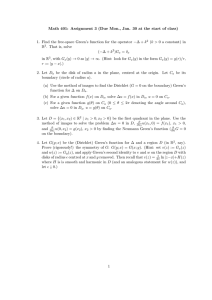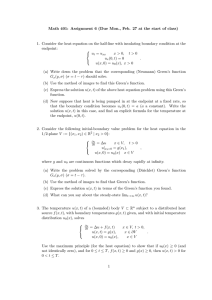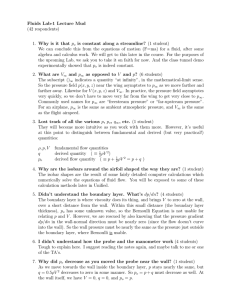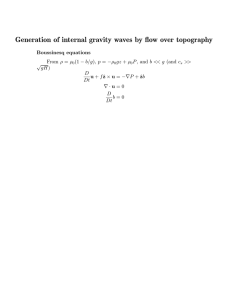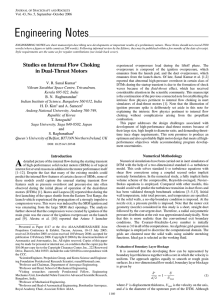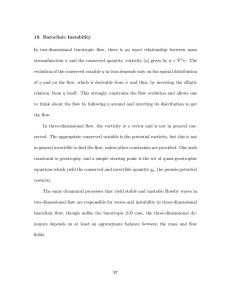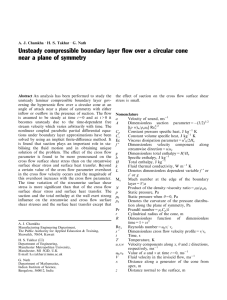The Heat Equation
advertisement
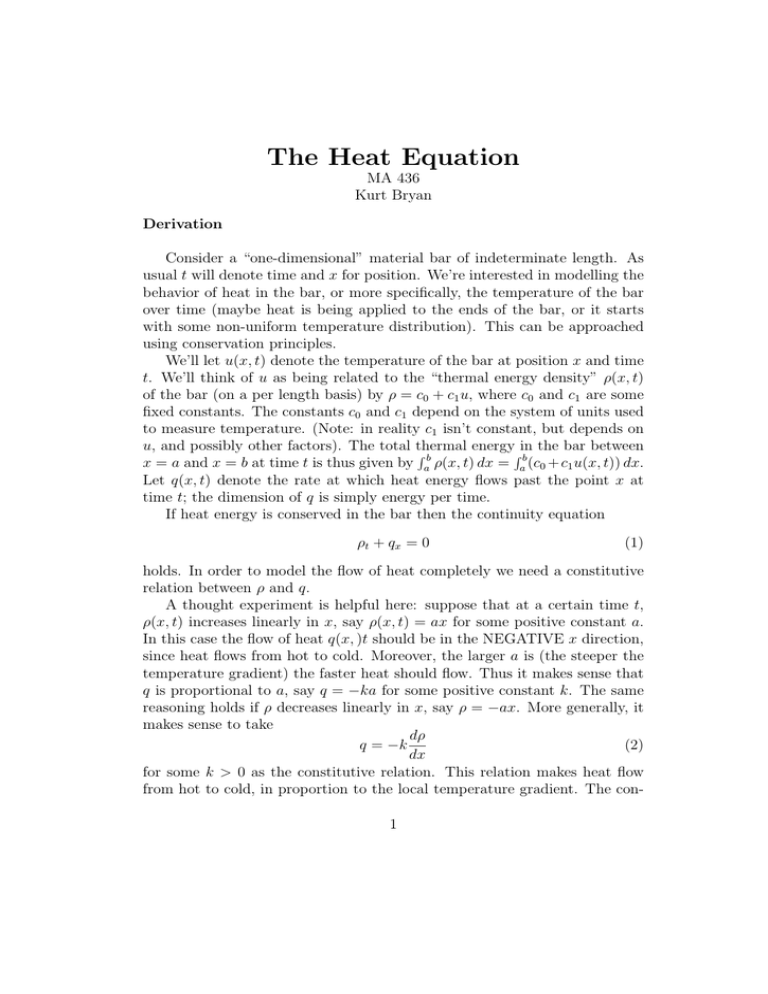
The Heat Equation MA 436 Kurt Bryan Derivation Consider a “one-dimensional” material bar of indeterminate length. As usual t will denote time and x for position. We’re interested in modelling the behavior of heat in the bar, or more specifically, the temperature of the bar over time (maybe heat is being applied to the ends of the bar, or it starts with some non-uniform temperature distribution). This can be approached using conservation principles. We’ll let u(x, t) denote the temperature of the bar at position x and time t. We’ll think of u as being related to the “thermal energy density” ρ(x, t) of the bar (on a per length basis) by ρ = c0 + c1 u, where c0 and c1 are some fixed constants. The constants c0 and c1 depend on the system of units used to measure temperature. (Note: in reality c1 isn’t constant, but depends on u, and possibly other factors). The total thermal energy∫in the bar between ∫ x = a and x = b at time t is thus given by ab ρ(x, t) dx = ab (c0 + c1 u(x, t)) dx. Let q(x, t) denote the rate at which heat energy flows past the point x at time t; the dimension of q is simply energy per time. If heat energy is conserved in the bar then the continuity equation ρ t + qx = 0 (1) holds. In order to model the flow of heat completely we need a constitutive relation between ρ and q. A thought experiment is helpful here: suppose that at a certain time t, ρ(x, t) increases linearly in x, say ρ(x, t) = ax for some positive constant a. In this case the flow of heat q(x, )t should be in the NEGATIVE x direction, since heat flows from hot to cold. Moreover, the larger a is (the steeper the temperature gradient) the faster heat should flow. Thus it makes sense that q is proportional to a, say q = −ka for some positive constant k. The same reasoning holds if ρ decreases linearly in x, say ρ = −ax. More generally, it makes sense to take dρ (2) q = −k dx for some k > 0 as the constitutive relation. This relation makes heat flow from hot to cold, in proportion to the local temperature gradient. The con1 stant k depends on the material out of which the bar is made and is related to the “thermal diffusivity” of the material. Using equation (2) to substitute out q in the continuity equation (1) yields ρt − kρxx = 0. This is the PDE that ρ must obey and is call the “heat equation”. It’s easy (use ρ = c0 + c1 u)) to see that the temperature u obeys the same equation. We’ll usually work in terms of the temperature u, since it’s a more familiar quantity. There’s another situation in which the heat equation frequently appears: when ρ(x, t) denotes the concentration of some substance dissolved in a medium in which the substance can diffuse. For example, ρ(x, t) could be the concentration of some pollutant in water. Most substances naturally “spread out” or diffuse from high concentrations to lower concentrations (just like heat), and so the heat equation is often a good description of this situation. The heat equation is in fact often called the diffusion equation. Initial and/or Boundary Conditions We’ll concentrate of the case k = 1, so we seek a solution u(x, t) to ∂u ∂ 2 u − 2 =0 ∂t ∂x (3) for t > 0 and x ranging over the bar of interest. In order to solve the heat equation we need an initial condition of the form u(x, 0) = ϕ(x) (4) for some initial temperature distribution ϕ(x) and each x in the bar, to specify the starting temperature at each point. If the bar is of infinite length then this is all we need (technically, we should also require u(x, t) to decay to zero as |x| → ∞; more on this later). If the bar is half-infinite or finite then we need a boundary condition at each end. There are two main types of boundary conditions. The first are the socalled Dirichlet boundary conditions, in which we specify the temperature of the bar at an endpoint, say x = 0, as u(0, t) = u0 (t) for some specified function u0 . If there is another end of the bar, say at x = L, we would also specify u(L, t) = uL (t) for some function uL . 2 The other common type of boundary condition is the Neumann condition, in which we specify the rate at which heat energy is being pumped into the ends of the bar. Now since q = −c1 ρx = −kc1 ux quantifies the rate of heat flow, we typically specify conditions like −kc1 ux (0, t) = ψ0 (t) (the rate heat ENTERS at x = 0) and kc1 ux (L, 0) = ψL (t) (the rate heat ENTERS at x = L) for functions ψ0 and ψL . A very common Neumman boundary condition is that no heat enters or leaves, so that ux (0, t) = ux (L, t) = 0 at all times. These are called insulating boundary conditions. One can also mix and match boundary conditions, i.e., have Dirichlet on one end and Neumann on the other, assuming the bar has two ends. The heat equation (3) together with an initial condition and (possibly) boundary condition at each end turns out to be uniquely solvable. Thought Problems • Suppose a bar starts off with constant temperature u(x, 0) = 10 and the ends of the bar are insulated. What is u(x, t) for t > 0? (Use your intuition). Verify that your solution really does satisfy the heat equation and Neumann boundary conditions. • Verify that with k = 1 the function u(x, t) = e−π t cos(πx) satisfies the heat equation with insulating boundary conditions on the interval 0 < x < 1. What is the initial condition? Plot the solution as a function of x for a few different times. Does it seem reasonable? 2 • Repeat the last problem but use u(x, t) = e−m is any integer. 2 π2 t 3 cos(mπx) where m


